Sukamto
Yayasan Dian Desa
Yogyakarta, Indonesia
1. BACKGROUND
Soya-bean cake is known in Indonesia as ‘tahu’. It is a daily staple food which is rich in protein, relatively cheap, and delicious. Tahu is consumed by all people regardless of their economic status. It can be prepared and consumed in many different ways. Tahu was originally brought to Indonesia by the Chinese centuries ago.
In Yogyakarta all tahu industries are small scale or cottage industries. Production is usually scattered in order to serve the market. However, due to the specific characteristics of the tahu making process, especially with regard to its waste products, the household industries usually form into tahu industrial centers. Most are located near rivers where they can dispose of the waste water.
Tahu is made of soya beans. The soya bean is finely ground and then boiled to make an extract that looks like milk. Some people like to drink this liquid as soya-milk. The extract is then strained through a fine cloth to produce the finest grade solution. This extract is then boiled for a long time. A small amount of acetic acid is added to act as a coagulant with the protein in the solution. Once the solution has settled, the water is removed and the white soft part is pressed so it becomes dense and hard. The tahu is then cut into small pieces and prepared for the market.
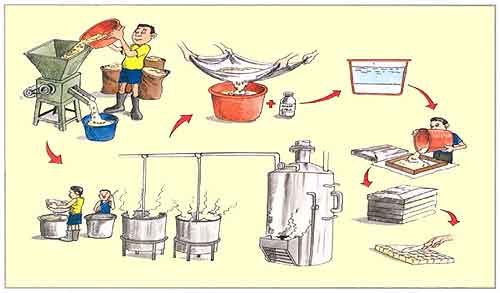
Tahu production flow diagram
Biomass fuel is an important part of the tahu industry because making tahu requires sustained boiling of large quantities of solution.
In Yogyakarta, there are two techniques for processing tahu: direct boiling and steam boiling. Steam boiling is actually a technique created by Mr. Taryono, a former trained mechanic who is now a tahu producer.
Biomass fuel is an important part of tahu industry because majority (90%) of the industries still use biomass as fuel. The fuel used includes wood, rice husk, coconut shell, leaves and sawdust. The type of fuel used depends on several considerations such as: fuel availability, cost, taste preference, efficiency (durability of utensils). Some producers have tried to change their fuel to kerosene but the woks do not last as long as those heated by biomass fuel.
The size of the production team varies from 2 to 25 workers and their production also varies from 25 kg of soya bean to 5000 kg/day.
The following case studies reflect the differences between direct boiling and steam boiling processing techniques.
II. THE PROCESSING TECHNIQUES
2.1. Tahu Making by Direct Boiling
The Stove
The stove used in direct boiling tahu production is a massive structure made of bricks and clay. The stove has a chimney which is also made from bricks and constructed up to the roof. A clay pipe, which is more resistant to the weather, extends the chimney above the kitchen roof.
Most of the stoves have two cooking holes, the first hole is used for boiling soya bean milk and the second hole is for boiling water. The diameter of the first is usually smaller depending on the size of the wok used. Small producers normally used single pot hole stoves with a smaller wok diameter.
The chimney is usually built at the corner of the stove with bricks. The height of the chimney is approximately 2.5 – 3 meters; and leads to the roof where the smoke can escape via a clay pipe from the work area. The chimney has no cap on its tip and smoke can easily be released from it.
| The stove is usually made by local artisans. The materials used are as follows: | ||
| The body | : | bricks, clay, sand and cement |
| The grate | : | strip metal |
| The foundation | : | stones with a cement mix ture as plaster |
The outside body of the stove is also sealed with cement mixture for increased strength and durability.
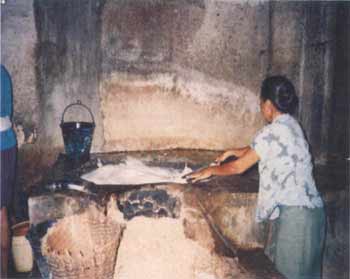
Typical of stove for Tahu making by direct boiling
The size of the two-pot-hole stove is 280 cm × 140 cm × 80 cm. The average height of the chimney is 3 meters.
According to Mr. Rasimun(63 years old) - one of the tahu producer at Pendowoharjo, Sewon, Bantul, Yogyakarta; local artisans can make the stove. There is no shortage of stoves or maintenance materials for anyone who wants to start tahu production. At the present price, one stove with two holes costs approximately Rp. 271,000. This consists of the following:
| 1000 bricks @ Rp. 75/piece | = | Rp. 75,000 |
| 2 m3 of clay @ Rp. 10,000/m3 | = | Rp. 20,000 |
| 4 m3 of sand @ Rp. 20,000/m3 | = | Rp. 60,000 |
| 3 bags (120kg) of cement @ Rp. 17,000 | = | Rp. 51,000 |
| 1 piece of iron bar (5/5) (3 m) | = | Rp. 15,000 |
| Labour cost: | Rp. 50,000 | |
| Total cost | Rp. 271,000 | |
 | 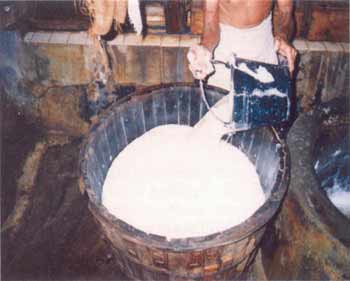 |
| The boiled solution is screen with fine cloth | Acetic acid is added to act as coagulant |
The stove takes 3 days to produce and can be used after 10 days. The stove he is using presently already more than ten years old and is still operating quite well. The main maintenance is required on the edges of the holes while the other flaws are cosmetic. Mr. Rasimun prefers using rice husk to saw dust for fuel, although both give good results.
The stove utensils in most cases consist of cast iron wok(s), which are affixed to the holes of the stove using a clay mixture.
The Fuel Used
Saw dust is the main fuel used for tahu processing in Yogyakarta. Fuel is collected from local saw mills using a big sack and transported by bicycle. The weight of each sack is approximately 80 kg.
Mr. Rasimun said that he has made tahu since he was 18. At the start he helped his father. After his father passed away he continued the family business. He said that when he was young, they used rice husks as the main fuel for making tahu. However, rice husks are getting more difficult to obtain. Mr. Rasimun attributes the scarcity of the husk to increased demand from brick and tile industries which are responding to increases in fuel wood prices. Tahu manufactures have started to use sawdust, or a combination of sawdust and rice husks, because it is more readily available. In terms of price, however, rice husk and saw dust are comparable at around Rp. 3,500 (US$ 0.50)/bag of around 40 kg.
The Production Process
In general the making of tahu by direct boiling comprises the following steps:
If two woks are used, the second wok is usually used to boil water so that the cooking process does not need to start with cold water. Therefore, the tahu making process becomes more efficient and can continue without interruption.
 |  |
| Cutting Tahu into pieces | Ready to market or consumed |
The stove is lit by pouring saw dust into the combustion chamber and using a little kerosene for ignition. The flames create a draft that goes into the chimney. The water in the two woks warms up to 60° C while the workers grind the soya beans. The grounded soya bean is poured into the hot water in the first wok. More water is added to the wok until it is full. The solution has to be stirred so that the solution will not burn. Once the solution thickens and reaches a temperature between 110° C – 125° C (which usually takes about 30 minutes), it is removed and screened with a fine cloth. During this process, the fire in the combustion chamber is reduced or even extinguished to avoid cracking empty woks due to over-heating.
Economic Aspects
In one day Mr. Rasimun processes 100 kg of soya bean. He prepares ten batches of solution which provide 7000 pieces of tahu. The whole cooking process takes around 3 hours continuous cooking. The total working hours though is 5 – 6 hours (including pressing, cutting and cleaning). To process 100 kg of soya beans into tahu, he needs 4 bags of saw dust.
Mr. Rasimun has 4 workers and is also helped by his wife who usually cuts the tahu. One piece of tahu is sold for Rp. 75.
The following is a simple financial calculation of Mr. Rasimun's tahu industry
| Production cost: | |||
| Soya bean 100 kg @ Rp. 4,000/kg = | Rp. | 400,000 | |
| 100 l of acetic acid | Rp. | 5,000 | |
| Fuel 4 bags @ Rp. 3,500 | Rp. | 14,000 | |
| Labor cost 5 @ Rp. 5,000 | Rp. | 25,000 | |
| Depreciation cost/day | Rp. | 20,000 | |
| Total production cost | Rp. | 460,000 | |
| Income: | |||
| 7000 pieces of tofu @ Rp. 75 | Rp. | 525,000 | |
| Profit/day | Rp. | 65,000 | |
2.2. Tahu Making by Steam Boiling System
The steam boiling system was invented by Mr. Taryono. His former job was to repair trains or locomotives. He began making tahu in 1996. He estimated a 5 kg loss for every 100 kg of soya bean processed due to burnt solution at the bottom of the wok. From his experience as a mechanic working with steam engines, he reasoned that if the soya bean solution was boiled with steam, there would be no losses due to burning. He developed steam boiling cookstove for tahu production that is the first of its kind.
The Stove
The stove is made of metal attached to the steamer pot. The unit also has a pipe to channel the steam to the four pots which are part of the system. A complete stove including the steamer, the pipes and the pots (4) costs Rp. 10,000,000. For a small scale industry, the start up capital is rather high.
However, because his design gives good results, people are starting to adopt his innovatory stove with some modifications of their own.
Mrs Hardi, for instance, has also been in the tahu making business for a long time. When she heard about the steam boiling system, she wanted to adopt it but she still wants to use the old brick stove because it reduces the cost of the system. The steamer is then placed horizontally instead of vertically across the brick stove top. Mrs. Hardi uses coconut shells as the main fuel source.
The Fuel Used
The main fuel used are rice husks. However, close to production center there is a eucalyptus oil production factory which produce leaves as waste products. Mr. Taryono also uses eucalyptus leaves whenever possible available because he only needs to cover the cost of transportation.
The Production Process
The production process for preparing tahu with steam is similar to the previously described method.
First the main tank is filled with water until it is around 80% full. Then the stove is ignited. While waiting for the water in the main tank to boil and produce steam, workers grind the soya beans. The ground soya beans are mixed directly with water. Once the water in the main tank starts boiling, each pot is filled with 4/5 ths of the way full with soya bean solution. After all the pots have been filled, the value is opened and the steam is allowed to get into the solution. This heat of the steam heats the solution. It usually takes around 7 minutes for the solution to start boiling.
 | 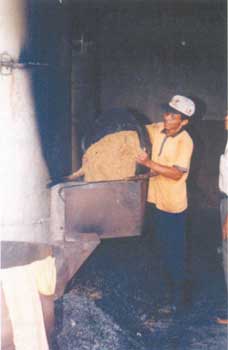 |
| Typical of steamer stove used in Tahu production using steam boiling system | Pouring the rice husk into burning chamber |
According to Mr. Taryono, this system produces better quality tahu without burning the base of the pots. He also explained that less fuel is required because whenever steam is not needed, the valve is closed and the steam is kept in the steamer. In addition, he says using this system saves approximately 1/3 (one third) the fuel that would have been used by a traditional stove with the direct boiling method.
Economic Aspects
Mr. Taryono explained that to cook 350 kg soya bean to make tahu, he needs 10 bags of fuel (rice husks). Compared to the traditional stove it saves 4 bags (160 kg) of fuel. Yet, the tahu produced is better quality because it is free from dust that can enter the unsealed pots or from the residual ash at the bottom of the pot.
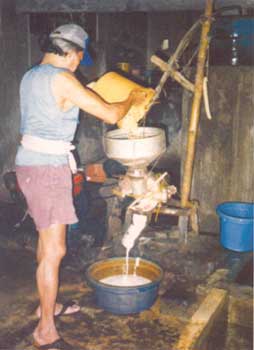
Grinding the soya bean using grinder machine

The solution in the tanks are heated by the steam
The following is the financial analysis
| Production cost: | ||
| Soya bean 350 kg @ Rp. 4000 | Rp. | 1,400,000 |
| 300 l acetic acid | Rp. | 15,000 |
| Fuel (rice husk) | Rp. | 30,000 |
| 8 laborers | Rp. | 40,000 |
| Depreciation cost | Rp. | 150,000 |
| Total cost | Rp. | 1,635,000 |
| Income: | ||
| 22 boxes @ Rp. 9,000 | Rp. | 1,818,000 |
| Profit/day: | Rp. | 183,500 |
Sometimes, Mr. Taryono is able to use the eucalyptus leaves waste from the eucalyptus oil production plant near his place. This source of fuel is virtually free. If he uses eucalyptus leaves, the cost for fuel spent is around Rp. 13,500/day. He usually hires a truck for Rp. 40,000 to pick up the eucalyptus leaves; one truck load of leaves will supply three days of production.
The working hours are from 7:00 to 15:00. Looking at the total working hours, the steam boiling system seems to work faster.□
K.M. Sulpya
RECAST
Kirtipur, Kathmandu, Nepal
I. BACKGROUND
Khuwa (whole milk solids) consists of the solid constituents of milk, including the milk fat. Milk fat is the main ingredient of many varieties of sweetmeat. The sweetmeats are deep fried in ghee (fats from milk) or edible oil while colours, flavours and toppings are added before or after frying. Sweetmeats are often used as offerings to the gods and goddess in Hindu culture. It is common in Nepal to eat sweetmeats with breakfast.
Nepal's main source of income in rural areas is buffalo or cow milk. Small scale khuwa industries are found in many rural areas of Nepal, particularly in villages surrounding the urban centres where sweetmeat shops are widely available.
The khuwa processing industry is generally a small scale cottage industry stewarded by household members. However, additional labour is hired for transporting khuwa to the urban sweetmeat shops.
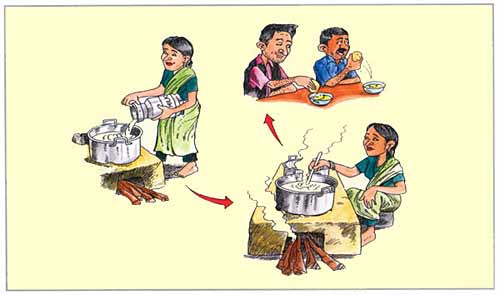
Khuwa production flow diagram
These industries provide a good source of income for rural entrepreneurs and extra income for households. However, these industries are endangered by dairy development programmes being launched in the rural areas as well as by lack of fuelwood for milk processing.
Milk, the raw material, is bought from the community in the vicinity of the villages. The cost of the milk depends upon its fat content as that determines how much khuwa can be produced. In general, the supply of milk is met regularly. However, supply is better during August to November and is worse during April to July.
Fuelwood is the major source of energy for this industry. The bulk of the fuelwood comes from the forests of the far west, more than 600 km from Kathmandu. These forests are being rapidly depleted. Therefore, the reliability of the fuel stock is decreasing while the price is increasing. In the absence of fuelwood the industries use root stocks which are drawn from the degraded forests. Sometimes, fuelwood is also purchased from urban areas.
The fuelwood purchased in the rural areas is transported by foot while if it is purchased in the urban areas it is transported by tractor.
II. THE STOVE
2.1. Stove Design and Its Features
The traditional wood burning stoves used in khuwa production vary from place to place. The size, shape, number of pot holes, etc. depends on the skills available as well as on the requirements of the cook. In Bhaktapur districts, three-pot-hole rectangular stoves are used for milk processing. The wood feeding hole is in the front. The first and second-pot hole are inverted cone shaped and the bottom of the round bottomed cast-iron pots (karai) sinks into the fire box. Because of this, the pots are tightly sealed on the pot holes. Only in the third-pot hole, there are three pot supports (piece of bricks) where the flue comes out from the stove.
The three-pot-hole stoves do not have baffles or chimneys. The combustion chamber is straight so that the cooks can add as much fuelwood as they want. The first and the second chambers both act as a fire box or combustion chamber, however the first chamber provides more fire than the second and third chambers. Even without a chimney, the third pot hole receives adequate heat to keep the milk warm.
2.2 Stove Construction Materials
The materials needed to construct one three-pot hole stove are 180 bricks, 2 buckets of cow dung, and 2 buckets of rice husk and mud.
Mud is mixed with cow dung for plasticity and rice husks for clay binding until the consistency of the mixture seems appropriate. There is no fixed proportion. The interior walls of the stove are lined with firebricks.
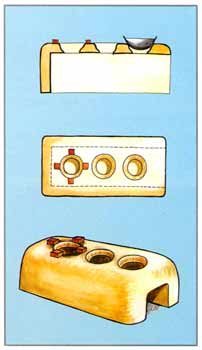
The internal configuration is rectangular. The pot hole configurations of the first and second- pot hole are shaped like an inverted cones so that round bottomed pots like karai can fit into them. This cone shape increases the surface exposure of the cooking pots to the fire, thus increasing the speed and efficiency of fuel use. No baffle is installed.
The dimensions of the stoves vary considerably from 74 cm by 158 cm to 84 cm by 167 cm and with a height of about 38 cm to 44 cm. The stove has a single opening of about 22 cm × 25 cm to 26 cm × 29 cm that serves as a fuel feeding hole.
2.3. Cooking Utensils and Design
Round bottom pans (karai) without lids are used for khuwa processing because continuous stirring is required during the process. The pans are made out of iron or cast iron. The round bottom makes it easier to stir the milk during the boiling or cooking process. The pans are 43 cm in diameter and 14 cm in height.
III. THE FUEL
Two different fuelwood types are the main fuels source for milk processing. The root stocks that are used are normally around 27 cm long and 3 to 8 cm in diameter while the timber production wastes (bakal) that are available in the market are normally around 210 cm long and 3 to 7 cm wide but they are not uniform in size.
During stove operation, 2 to 4 firewood sticks (depending on the size of the firewood) are kept burning. During the cooking process the fire requires constant vigilance to prevent the milk from burning. The root stocks are used for kindling. No pre-treatment nor chopping is done as the bakal firewood is used as it is. Based on measurement, the average moisture content of the firewood was 12 percent. Normally, after the milk processing is completed, the firewood to be used the next day is stored on the warm stove that the firewood will be dry to some extent and thus easier to light. Green wood is never used because the moisture produces too much smoke.
3.1 Heat and Combustion
In the process of khuwa making, three big cast iron round bottomed pans (karai) with a capacity of 6 litres each is placed on a three-pot-hole stove. Each pan is filled with 2.3 litres of milk leaving enough space for the handling and boiling of milk. The pans are heated by burning firewood. The boiling temperature of the milk reaches around 96° C. The cook has to continuously stir the milk in the first and second pans to prevent the milk from burning. The process continues until the milk in the first pan solidifies. The first pan is then replaced with the second pan in which the milk is slowly boiling, and the second pan is replaced with the third pan containing warm milk. The thick milk paste (khuwa) is taken out from the first pan, and the pan is placed on the third-pot hole and filled again with 2.3 litres of fresh milk. The process continues until all the milk has been processed into khuwa.
 | For efficient processing, some entrepreneurs have designed three-pot hole stove so that they can use the excess heat in second and third pot holes. |

The milk is stirred continuously to prevent from burning
During the cooking process, the temperature at the combustion chamber is between 540 to 804° C. Normally, the temperature is around 715° C. The temperature lowers when firewood is added. The temperature in the second chamber is similar to the first one, i.e. between 517 to 800° C and the maximum temperature attained in the third chamber is 570° C. During the combustion period, the colour of the flame is yellowish red and the hot flue gases pass directly under the round bottomed pan and towards second-pot hole and remain in the third-pot hole.
Charcoal and ash are by-products of the fuelwood used after the processing. Thus the stove remains hot and they utilize the heat of the stove to dry the fire wood that they will use the next day
3.2. Operation and Maintenance
During the cooking process, heat is controlled by adjusting the amount of fuel. The stove is very simple. It has no secondary air hole, grate, door, etc. The stove is well maintained by the users. The pans fit tightly on the pot holes to prevent the milk from burning. This also reduces the amount of heat that reaches the cook who is responsible for stirring the milk.
IV. THE PRODUCTION PROCESS AND COOKING PRACTICE
Khuwa processing technique is similar throughout Nepal. It is processed by boiling milk in a half-circle-metal pot until it solidifies. During the boiling the milk is stirred continuously to prevent burning. For efficient processing, some entrepreneurs have designed three-pot-hole stove so that they can use the excess heat in second and third-pot hole. The stove allows them to use three pans at a time. This helps them to reduce processing time and create more conformable working conditions. In a one-pot-hole stove 4.5 litres of milk take 80–90 minutes to process into khuwa (1 kg of khuwa) while in a three-pot-hole stove, it takes about 25–30 minutes. The general condition of the kitchen is not well maintained.
The kitchen has proper lighting and ventilation but it is not well maintained. The cook remains seated during the cooking process.
During processing, continuous firing was observed in two processing units. Both the stoves are of the same design but differ in dimensions. The firing process is similar. The cooks are well trained and have processed khuwa for many years. They are quite experienced in controlling over-heating or under heat by adjusting the firewood. They never allow flames to lick the side of the pans as it will cause heat loss and burn the milk, as well as expose the cook to too much heat.
V. PROBLEMS AND CONSTRAINTS IN THE UTILIZATION OF THE STOVES
At present, the stoves that are being used are three-pot-hole stoves. These stoves are improved versions of the single-pot-hole stove. stove users prefer these stoves because they consume less fuel. However, the stove users still feel that the stoves consume too much fuel. They would like to have a more fuel efficient cookstove alternative.
The khuwa production process takes a long time, that is between 10 to 12 hours. The conditions in the kitchen are worse during summer as the kitchen becomes very hot, especially those that have no chimney installed.
The scarcity of fuelwood supply in rural areas is a growing problem in Nepal. Many milk processing industries have an uncertain future due to the increases in the price of fuelwood.
VI. ECONOMIC ASPECTS
Producers collect milk every day and pay on monthly basis. The price of milk depends on the ratio of khuwa production. According to the entrepreneurs, 3.8 litres of milk give 1 kg of khuwa. The khuwa production cost is minimal as presented below:
6.1. Cost Calculation of Stove Production
The existing traditional stoves cost around Rs. 400 only. Cost calculation of stove production is given below.
| 180 bricks | - | Rs. 270 |
| 1 day's labour | - | Rs. 110 |
| 2 buckets of cow dung | - | Rs. 15 |
| 2 buckets of rice husk | - | Rs. 5 |
| Rs. 400 |
6.2 Expected Durability of Stove
The stove is made of locally available materials and there is hardly any cost needed for maintenance. During use, the walls may crack but are quickly patched with a mixture of mud, cow dung, and rice husk. The stove is quite durable and may last for 10 years if properly maintained.
6.3. Capital Input Vs. Economic Output
As seen from the calculations, khuwa industries have a high rate of return on their initial investment (profit amounts to 169%) or a profit equal to 23.2% of the production cost. Even with that good profit, the production of khuwa is decreasing because of lack of fuelwood in the rural areas.
6.4. Fuel Used in Total Production Process
An economic analysis has been carried out for reference purpose. The analysis is based on case studies. The calculations are given below. The case studies show that specific fuelwood consumption varies within the range of 3.560 to 3.710 kg of fuelwood per kg of khuwa produced. On average, 3.635 kg of fuelwood is consumed per kg of khuwa production (Table 1). And the cost of fuelwood per kg of khuwa is about Rs. 14.54 (14.5% fuelwood cost per kg of khuwa).
The specific fuelwood consumption varied within the range of 0.880 to 0.928 kg of fuelwood per litre of milk process. In one-pot-hole stove, the specific fuelwood consumption varied within the range to 2.8 to 5 kg of fuelwood per kg of khuwa production in lkudole village of Lalitpur District. In lkudole village, fuelwood is collected by family members. Based on the cost of wages and food, one kg of fuelwood costs around Rs. 1/50 per kg which is about 3% fuelwood cost per kg of khuwa (in lkudole on average 1 kg khuwa costs Rs. 50 per kg.).
Table 1. Results of Khuwa Production Tests
| Stove A: K.B. Shresta | Stove B: N.K. Kayastha | ||||||||
| Quantity of milk | Wt. of khuwa | Quantity of fuel used | Quantity of milk | Wt. of khuwa | Quantity of fuel used | ||||
| Day | (lt) | (kg) | (kg) | Time | Day | (lt) | (kg) | (kg) | Time |
| 1 | 45.1 | 11.2 | 45.5 | 09:30 | 1 | 34.3 | 8.5 | 27.8 | 07:20 |
| 2 | 52.0 | 12.5 | 44.2 | 11:15 | 2 | 31.4 | 7.8 | 27.2 | 07:45 |
| 3 | 40.0 | 9.7 | 41.0 | 10:45 | 3 | 36.0 | 9.1 | 32.7 | 08:05 |
| 4 | 46.8 | 11.9 | 42.5 | 10:50 | 4 | 22.8 | 5.6 | 22.5 | 07:10 |
| 5 | 58.2 | 15.0 | 51.6 | 11:30 | 5 | 29.1 | 7.0 | 25.1 | 01:15 |
| Avg | 48.4 | 12.1 | 44.9 | 10.57 | Avg | 30.72 | 7.6 | 27.06 | 07.39 |
Remarks: Pan balance is used for the tests. Fuelwood with 12% moisture content was used.
Stove A: Water Boiling Test (WBT) gave 16.08 HU with 37.59 m/min.
Stove B: WBT - 18.21 HU with 25.9 gm/min Burning Rate (BR)
6.5. Economic Analysis of Small Scale Khuwa Industry
Khuwa Industry Sudal Village, Bhaktapur District
| Stove type | : Three-pot hole stove | |
| Fuel type | : Sal (Shorea robusta); Chilaune (Schima wallichi); Katus (Castonopsis sp), | |
| Employment | : Three | |
| Operation | : 11 hours per day | |
| Working days | : 350 days | |
| Total Investment | : Rs. 3,900. | |
| a) Fixed cost | ||
| Stove production | - Rs. 400. | |
| Pans | - Rs. 900. | |
| Stirrer | - Rs. 150. | |
| Bowls | - Rs. 50. | |
| Rent (shade) | - Rs. 400. | |
| Rs. 1,900. | ||
| b) Variable cost | ||
| Fuelwood for 7 days | - Rs. 1,400. | |
| Labour cost for 7 days | - Rs. 2,400. | |
Production Cost per Month
| Item | Quantity | Cost in Rs. |
| Milk | 1337 | 18720 |
| Fuelwood | 1365 kg | 5460 |
| Labour | Rs.60/- × 2 | 3600 |
| Part time | 7 days/month | 700 |
| Total monthly production cost | = Rs. 28,480. |
| Total weight of khuwa produced per month | = 351 kg |
| Average cost of khuwa per kg | = 100 |
| Total revenue per month | = Rs. 35,100. |
| Total profit per month (excluding tax) | = Rs. 6,620. |
| Profit %, of the production cost | = 23.2 |
| Profit % of total investment | = 169.1 |
VII. SUGGESTIONS FOR FUTURE DEVELOPMENT
Khuwa production is impaired by the lack of reliable, affordable fuelwood. Therefore a more efficient stove may be needed by the khuwa producers
Based on analysis of stove used, same suggestions for future development are recommended as follows:
The one-pot-hole stove, should be made into a three-pot-hole stove and the pot holder should be converted into an inverted cone shape as done in Sudal village of Bhaktapur District. This will help to use waste heat and to make the work environment more comfortable.
In three-pot-hole stove, the combustion chamber should be reduced, baffles should be introduced. During the summer, the cooks suffer excess heat while they use the stove. They also suffer from smoke, thus a smoke extractor is recommended. The smoke extractor will not be directly coupled with the stove. The smoke extractor offers many advantages not generally associated with chimney stoves. The smoke extractor works on the principle that sufficient waste heat is available to rise up a chimney supported above the heat source. Smoke and other emissions are drawn from the cooking process into the chimney air above the heat source.□
K.M. Sulpya
RECAST
Kirtipur, Kathmandu, Nepal
I. BACKGROUND
Candy Lapsi (Spondais sps.) plant is a special kind of tree that is available in some parts of Nepal only. The fruit is small and contains a seed. From generation to generation, the fruit has been mixed with salt and water to make a drink during feasts and festivals. The drink is sour because it contains citric acid. Lapsi is believed to help digest food.
Lapsi candy is prepared from the lapsi fruit. This candy is popular mainly among young women and girls. Because of product diversification, the industry is growing very fast and high quality candy is exported to India, Australia and Saudi Arabia. The export quantity is very small however, and domestic demand is often so high that producers can not meet the domestic demand.
Lapsi fruit processing and candy preparation is classified as a small scale cottage industry in Nepal. It is also identified as a traditional food processing industry. These industries provide a good source of income for rural entrepreneurs and extra-income for households. More and more people are involved in these businesses because of the high demand for the processed products.

Candy Lapsi processing flow diagram
The raw materials used in this industry are lapsi fruit, salt, pepper, sugar, chilli powder, preservatives (bechi, chakuwasa) and all are readily available in the local market.
The lapsi fruits are collected from the rural areas. Middlemen travel to rural areas when fruiting starts and give advances of Rs.400 to Rs.500 per plant to the farmers. When the fruits are ready to be harvested, the middlemen collect the fruits and supply them to the industries. The supply of fruits is more or less regular because of the involvement of middlemen in this business. The price of and demand for lapsi fruit is increasing each season. Thus, growing it generates a good income for the rural people.
The industry is a small scale cottage industry. It is also a labour intensive business which requires the help of all available family members. Additional labour may be needed for firing the stove, screening the pulp and seeds, cutting, packaging, transporting, etc.
The government's Food Research Laboratory provides training on candy making techniques. Most of the people who run this candy business do not have any formal training from any institute but instead learn the process from family members.
Biomass fuel is the main source of energy for this industry. Agri-residues like wheat straw, rice husk are obtained as agricultural by-products. These residues are collected from different sources and stored until needed. The cost of agri-residues (wheat straw) is about Rs.4.80 per kg. which is more expensive than fuelwood. Similarly, the cost of rice husk is Rs.1.60 collected from local areas. During seasons when agr-iresidues are scarce, the lapsi industry depends on fuelwood. The supply of fuelwood from local areas has lessened due to the scarcity of available forests. Thus, for fuelwood, the industry has to depend on timber offcuts (bakal) which are supplied to Kathmandu from the southern parts of Nepal. The cost of bakal is about Rs.3.50 per kg.
II. THE STOVE
2.1. Stove Design
The brick stove used for lapsi fruit processing has an open fire, thus during firing a lot of heat is lost. Heat is also lost from the wood feeding hole. Normally one industry will have 5 to 10 stoves and light the stoves one at a time. Because of this it is difficult to control the fire and it is worst if agri-residues are used as fuel.
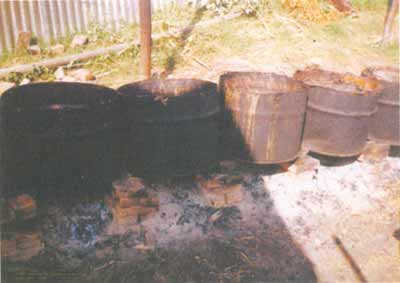
Half cut drums are used for cooking the Lapsi fruit
2.2. Stove Construction and Materials
The stove is generally made out of bricks. Some are made simply using mud and bricks. The stove has one-pot hole and the interior is rectangular. The internal dimensions of the stoves are 25 cm height, 36 cm wide. The stove has one wood feeding hole but there are two other small openings for removing ash.
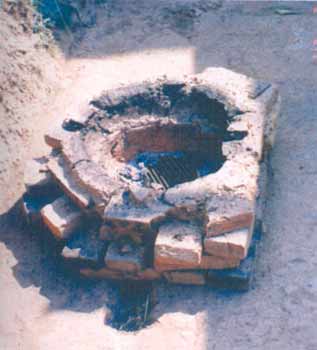
A single brick stove for Lapsi processing
III. FUEL USED AND PREPARATION
Agri-residues and fuelwood are the main fuels used for cooking lapsi fruits. Agri-residues include wheat straw, rice husk, maize cobs, and other bushes and twigs. Timber off-cuts (bakal) fuelwood are also used and are around 210 cm long and 3 to 7 cm wide but they are not uniform in size.
During cooking operations, one small bundle of wheat straw of about 62 g. is kept for burning. Then after that 31 g of wheat straw is added at a time. The wheat straw is spread inside the combustion chamber so that the pot is evenly heated. When using fuelwood, the pot must be fired otherwise the fruits may not be fully cooked.
During the rice husk season, a bed of rice husks is prepared and then fuelwood or agri-residues are burned. This combination of fuel provides continuous heat and also saves money.
3.1. Heat and Combustion
In the process of lapsi cooking, half cut drums of 90 litres capacity each are kept on an open fire (made out of bricks or mud bricks) and filled with 75 kg of lapsi fruits and 5 litres of water. Each is covered by a jute sack. The boiling and simmering is done with agri-residue fuel. The boiling temperature was found to be around 96 degrees Celsius. The fire requires continuous attendance. The contents are never stirred and firing is continued until all of the lapsi fruits are cooked properly. The cooks say that agri-residues ensure a steady, stable flame whereas firewood requires continuous attendance lest the fruits burn.
During the boiling period the temperature of the combustion chamber was found to be around 628 degrees Celsius. The temperature lowers when the agri-residues are added. During the combustion period, the colour of the flame was yellowish to yellowish red and hot flue gases and flames emanated from the pot. The stove produced smoke.
3.2. Operation and Maintenance
The heat is controlled by adjusting the fuel and requires continuous attendance. The cook decides how to adjust the fuel levels.
3.3. Cooking Utensils and Design
For lapsi fruit processing, half-cut drums are used. Some processors use cylindrical aluminium pots. The half-cut drums have a diameter of 54 cm and are 60 cm high, while the aluminium pots have a diameter of 62 cm and are 45 cm high.
IV. PRODUCTION PROCESS
Lapsi fruits are cooked in the half circle shaped drum. 75 kg of lapsi fruit are cooked at a time. Only 5 litres of water is kept during cooking. During the boiling period, the fruits are covered by a jute sack to prevent evaporation. The cooking is done above an open fire. The entrepreneurs use 6 to 10 open fire at a time so that one or two persons can monitor the fire. After the fruits have been boiled, 5 kg of salt are added to the mixture. The salt makes it easier to peel the fruit skin, increases weight and acts as a preservative of the processed product.
The cooked fruits are kept in a machine which kneads the cooked fruits and separates the fruits from the seeds. After two to three times, the remaining seeds are removed by hand. The processed fruit is like pulp and is stored underground inside plastic covered receptacles for more than 8 months. The use of salt extends the storage life of the pulp beyond 8 months.
The pulp is the main raw material for candy preparation. Depending on the quality of the candy, fine pulp without fruit skin is taken out and mixed with sugar, pepper, chilli as desired, and dried in the sun or in a solar drier or electric oven. For normal candy preparation, the pulp is plastered on wooden planks and dried in the sun. It takes 3–5 days to dry and process the pulp into candy products. Some preservatives are also added to the finished products.
Workers are seated for the duration of the production process.
4.1. Tricks Employed During Processing
During cooking, continuous firing was observed in two processing units. Both the stoves had the same design and size. In one stove the firing was done by the owner and in the other by the labourer. The labourer added more fuel than was needed but the lapsi cooked fast The owner controlled the fire in the hope of minimising the fuel consumption during and after the cooking process. He lowered the fire so that the minimum amount of heat needed was used.
V. ECONOMIC ASPECTS
For reference purpose the economic analysis of the small scale lapsi candy industry has been given. To run this industry a stock of raw materials and processed raw materials are necessary because it is seasonal work and because there is a good market for the product.
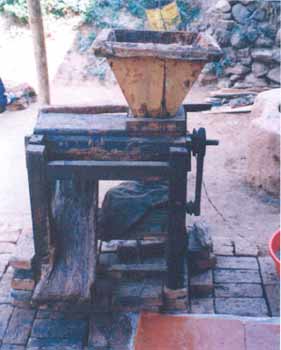
A simple machine for kneads and separates the fruits from the seeds
5.1. Cost Calculation of Stove Production
The existing traditional stove costs about Rs.40 only. The traditional stove has three stones/bricks stove.
5.2. Capital Input Vs. Economic Output
As seen from the calculations, candy industries have a better return on their investment (profit amounts to 214.5% of the total investment). Because of the profit, these industries are growing and some entrepreneurs are producing high quality candy for export.
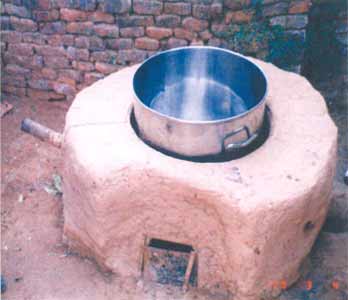 | 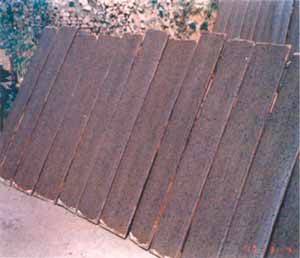 |
| Typical of improved stove for cooking the Lapsi fruit | The lapsi pulp is plastered in wooden plank and dried under the sun |
5.3. Biomass Used in Total Production Process
Based on the case studies, fuel consumption depends on the discretion of the cooks. On average, boiling 75 kg of lapsi fruits in two stoves of the same size but with different cooks consumed 10.2 kg and 7.3 kg of biomass fuel respectively. On average, the specific fuel consumption is 0.117 kg of biomass per kg of fruit cooked. The cost of biomass fuel (wheat straw) per kg of raw candy is Rs.2.39 (4.78% biomass fuel cost per kg of candy).
The cost of wheat straw fuel is more expensive than fuelwood. The cost of wheat straw comes to Rs.5 per kg, while the cost of fuelwood in the study area is Rs.3.75 per kg.
VI. PROBLEMS AND CONSTRAINTS IN THE UTILIZATION OF THE STOVE
This rural industry is labour intensive and needs considerable space. Because of this, the stoves are installed outside the house or in an open field. Because the stoves have open fires, a lot of heat is lost during the cooking of lapsi fruits and it is difficult to work nearby the stoves. To avoid excessive heat, cooking starts either in the early morning or after 3 PM.
Normally the industry uses 5–10 stoves at a time and requires about 2 to 3 hours to complete the cooking process. It is difficult for one or two people to maintain the fire if they use agricultural residues. Depending on the season, they use a combination of fuelwood, agri-residues and seeds of the lapsi fruits. If agr-iresidues are used, the cook must remove the ash frequently to ensure a steady temperature.
These small scale industries are hampered by the unreliable supply of good quality fuelwood. When coupled with the rise in the price of fuelwood, many processors may feel compelled to substitute fuelwood by kerosene. Some entrepreneurs have already switched to kerosene.
6.1. Production Cost and Economic Analysis of Small Scale Candy Industry
| Candy Industry | : Sanga village, Kavrepalanchock district |
| Stove type | : Three stones |
| Fuel type | : Agri-residue, fuelwood |
| Employment | : Nine |
| Operation | : 8 hours per day |
| Working days | : 18 days fruit processing, 340 days candy production. |
Total Investment
| a) | Fixed Cost | ||||
| Room rent | - | Rs. | 1,440. | ||
| Stove production | - | Rs. | 40. | ||
| Pots | - | Rs. | 3,200. | ||
| Stirrer | - | Rs. | 200. | ||
| Buckets | - | Rs. | 150. | ||
| Bowls | - | Rs. | 600. | ||
| Shade | - | Rs. | 1,000. | ||
| Pit | - | Rs. | 320. | ||
| Extruder | - | Rs. | 12,000. | ||
| Scissors | - | Rs. | 320. | ||
| Cutting machine | - | Rs. | 8,000. | ||
| Plastic sheet | - | Rs. | 500. | ||
| Wooden plank | - | Rs. | 4,000. | ||
| Rs. | 44,730. | ||||
| b) | Variable Cost | ||||
| Agri-residue/fuelwood for 2 weeks | - | Rs. | 1,632. | ||
| Working capital : labour cost for 2 weeks | - | Rs. | 7,560. | ||
| Raw material stock (fruit/raw processed for fruit processing fruits) | - | Rs. | 105,000. | ||
| Total investment | Rs. | 158,922. | |||
| Annual Production Cost | |||||
| 1. | Depreciation | ||||
| a) ahead 4% | - | Rs. | 40. | ||
| b) pots, bowls, cutting machine, 10% | - | Rs. | 2,897. | ||
| Total depreciation | Rs. | 2,937. | |||
| 2. | Interest on fixed assets 18% interest on (75% of fixed assets) | - | Rs. | 33,548. | |
| 3. | Raw materials costs per year costing of: | ||||
| a) fruits 2160 kg//5 months | - | Rs. | 240,000. | ||
| b) sugar 1440 kg/yr | - | Rs. | 34,560. | ||
| c) salt 1620 kg/yr | - | Rs. | 8,100. | ||
| d) ingredients 288 kg/yr | - | Rs. | 11,520. | ||
| Total cost | Rs. | 294,180. | |||
| 4. | Direct labour cost | - | Rs. | 191,400. | |
| 5. | Cost of packaging material | - | Rs. | 20,000. | |
| 6. | Cost of water and electricity | - | Rs. | 6,000. | |
| 7. | Interest on working capital (50% of Rs. 114192 at 18% per year) | - | Rs. | 10,277. | |
| Total annual production cost | - | Rs. | 547,153. | ||
| Annual Sales | |||||
| 75 kg of fruits give 3.7 kg raw candy | |||||
| 5 months fruit processing gives | - | Rs. | 888,000. | ||
| Total annual income | - | Rs. | 888,000. | ||
| Annual profit | - | Rs. | 340,847. | ||
| Annual profit equals to 214.5% of the total investments. | |||||
Table 1. Results of Lapsi Fruit Cooking Tests
| Stove A: Laxmi Maharjan | Stove B: Laxmi Maharjan | ||||||
|---|---|---|---|---|---|---|---|
| Weight of Lapsi Fruit | Quantity of Fuel used | Weight of Lapsi Fruit | Quantity of fuel used | ||||
| Day | (kg) | (kg) | Time(hr) | Day | (kg) | (kg) | Time (hr) |
| 1 | 75 | 7.0 | 1.55 | 1 | 75 | 10.4 | 1.10 |
| 2 | 75 | 6.5 | 1.73 | 2 | 75 | 11.2 | 1.05 |
| 3 | 75 | 8.5 | 1.41 | 3 | 75 | 10.8 | 1.12 |
| 4 | 75 | 8.2 | 1.50 | 4 | 75 | 8.8 | 1.45 |
| 5 | 75 | 6.4 | 1.72 | 5 | 75 | 9.9 | 1.30 |
| Avg | 75 | 7.3 | 1.58 | Avg | 75 | 10.2 | 1.20 |
Remarks: Local measurement ‘Pathi’ is used and converted in into kg.
An balance is used for fuel (wheat straw) measurement.
Stove A: WBT - 11.82 HU with 138.9 gm/min BR.
Stove B: WBT - 10.06 HU with 160.9 gm/min BR.
VII. SUGGESTIONS FOR FUTURE DEVELOPMENT
Candy processing is a profitable business which must grow quickly to keep up with the demand for the processed products. However, the irregular supply of biomass fuel (including fuelwood) is making it difficult for entrepreneurs to maintain their level of productivity.
Based on analysis of stove used, suggestions for future development are as follows:
In candy processing occurs during the early morning or after 3 pm to avoid excessive heat; if the open fire is
contained, production can occur at more flexible hours. The pot used for the fruit processing is cylindrical, so
if the pot is sunk into the combustion chamber, more heat will transferred around the pot. Therefore the cook
will be exposed to the less heat. Metal grate should also be introduced so that the cook can easily removed
the ash below the grate without disturbing the fire and increase air circulation in the combustion chamber. This
type of stove will be 28% more efficient.
At present, most fruit processing centres in open fields are not hygienic. If possible, the cooking facilities in the open fields should be enclosed and provided with the necessary infrastructure for sanitation. Proper production methods will help secure a market for exports.□